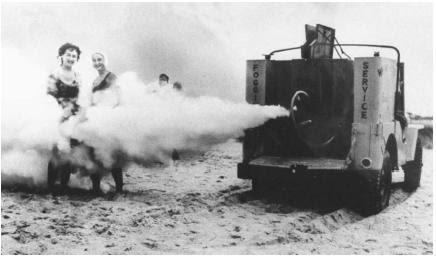The Hidden Parallels: DDT, Polio, and the Modern COVID Era

Image Source:
There’s a story not many people are talking about—a striking parallel between two moments in history that raises questions about government intervention, public health narratives, and the influence of powerful industries. Let’s dive into the eerie similarities between what I’ll call the "Fake Polio Outbreak" of the 1940s and the "Fake COVID Pandemic" of recent years. Buckle up, because this isn’t the sanitized version you’ll find in textbooks.
DDT and the Polio Mirage
Back in the 1940s, the U.S. government rolled out a bold solution to the terrifying polio epidemics that gripped the nation every summer. The weapon of choice? DDT, a pesticide hailed as a miracle cure. They didn’t just spray it on crops—they doused entire communities with it. Historical footage shows children running through clouds of DDT mist, trucks spraying it over neighborhoods, and even food and drink being laced with this supposed savior. The narrative was clear: DDT would kill polio by targeting the flies some believed spread the disease. The government assured everyone it was safe—safe enough to bathe in, safe enough to eat.

Image Source: https://www.ewg.org/news-insights/news/ddt-not-healthy-children-and-other-living-things
But then people got sick—really sick. Paralysis, neurological damage, and a host of mysterious symptoms started cropping up. The official story? It was all due to polio, a viral scourge that just happened to spike at the same time. Never mind that DDT, a neurotoxic organochlorine, was being absorbed through skin and ingested daily. The government’s word was gospel, and questioning it wasn’t on the table. Sound familiar?
Here’s where it gets interesting: polio cases plummeted not long after DDT use began to wind down. By the early 1950s, communities stopped spraying it to control polio, and the pesticide was banned in the U.S. in 1972 after mounting evidence linked it to health and environmental disasters. Meanwhile, the polio vaccine, introduced by Jonas Salk in 1954, took all the credit for wiping out the disease. But hold on—polio was already on the decline before the vaccine’s widespread use, and some researchers argue that DDT poisoning might have been misdiagnosed as polio all along. A 1946 newsreel from San Antonio, Texas, shows the city being sprayed with DDT to curb a polio outbreak—an effort we now know was futile against a virus spread through fecal-oral transmission, not insects. Coincidence that polio faded as DDT did? I’m not so sure.
The COVID Echo
Fast forward to 2020, and we see a haunting rerun. A "pandemic" bursts onto the scene, and the government leaps into action with a solution: a rushed COVID vaccine, pushed as the only way out. Just like with DDT, the messaging was relentless—trust the science, take the shot, save the world. But as adverse reactions piled up, a familiar pattern emerged. Instead of scrutiny, we got censorship. Studies questioning the vaccine’s safety or efficacy were labeled "misinformation" faster than you could say "peer review." The government teamed up with Big Tech—think Twitter, Facebook, and Google—to silence dissent, shielding what I’d call the pharma crime syndicate from accountability.
And who laid the groundwork for this? None other than Senator Ted Kennedy, whose 1986 National Childhood Vaccine Injury Act (NCVIA) gave vaccine manufacturers a golden ticket: immunity from lawsuits. Signed into law on November 14, 1986, this legislation created a no-fault compensation program for vaccine injuries, funded by a tax on vaccines, while shielding pharmaceutical companies from direct liability. The idea was to keep vaccine production humming by reducing legal risks—after all, companies were threatening to abandon the market amid rising lawsuits. But here’s the rub: if these vaccines were so safe, why did they need a legal forcefield? By 1986, the number of vaccine makers had already dwindled from 26 in 1967 to 17 in 1980, partly due to litigation fears, and Kennedy’s act was the fix. Critics argue it handed Big Pharma a blank check to prioritize profits over safety, a playbook we saw again with COVID.
Connecting the Dots
The parallels are uncanny. In the 1940s, DDT was the "cure" that wasn’t, and the government pinned the blame on a virus while ignoring the poison in plain sight. With COVID, we got a vaccine rollout shrouded in secrecy, protected by a system Kennedy built decades earlier, and a crackdown on anyone daring to ask questions. Both eras feature a government-industrial alliance—DDT makers and the March of Dimes back then, Big Pharma and Big Tech today—pushing a narrative while dismissing the fallout. Polio vaccines, too, weren’t flawless; early batches caused injuries and even paralysis, yet the story stayed rosy. COVID’s adverse events? Swept under the rug with the same vigor.
Private citizens aren’t buying it anymore. If vaccine manufacturers need immunity from lawsuits—immunity Ted Kennedy cemented in 1986—it’s a glaring red flag they’re not acting in good faith. Why protect an industry that injures people if the products are as safe as claimed? The DDT debacle showed us that government solutions can backfire, leaving a trail of sickness blamed on something else. COVID feels like history rhyming, and people are waking up to the tune.
Final Thoughts
The truth is messy, and history doesn’t always reward the skeptics in real time. But looking at DDT in the 1940s and the vaccine shield of 1986, one thing’s clear: when the government and industry lock arms, the people pay the price. Polio didn’t vanish because of a magic shot alone—DDT’s exit played a role. COVID’s story isn’t over, but the cracks in the narrative are showing. Maybe it’s time we stop swallowing the official line and start digging for ourselves.

Image Source: https://www.ewg.org/news-insights/news/ddt-not-healthy-children-and-other-living-things
Source: DDT and Polio in the 1940s:
"This Week in Universal News: Spraying DDT to Prevent Polio, 1946" – The Unwritten Record, National Archives. Describes San Antonio’s 1946 DDT spraying campaign to combat polio, a misguided effort later debunked. "A misfire in fighting polio provides clues as to how we’ll beat covid" – The Washington Post, April 14, 2022. Details how DDT was sprayed in the 1940s and 1950s to fight polio, with its use fading by 1953 as the vaccine took center stage.
Source: Ted Kennedy and the 1986 Vaccine Act:
"1986: The Act" – Children’s Health Defense. Examines the National Childhood Vaccine Injury Act, signed into law on November 14, 1986, and its implications for shielding vaccine manufacturers.
You received an upvote ecency